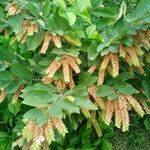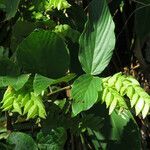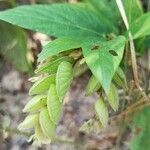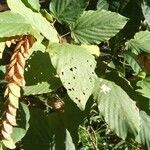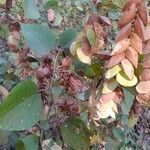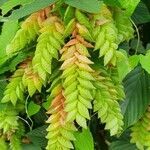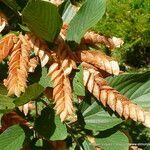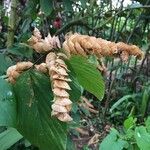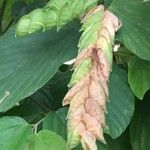Shrub or subshrub; stems terete, strigose. Leaves unifoliate; leaflet ovate to obovate, 9.5-15.0 cm long, 4.0-9.0 cm wide, apically acute, basally truncate to cuneate, glabrous to puberulent above, gland-dotted to villous beneath, the mar-gins revolute; petiole 1.0-2.0 cm long, strigose; stipules lanceolate, striate, 3.0-4.0 mm long, caducous. Inflorescences exceeding the leaves, racemes or terminal panicles, distichous, 6.0-15.0 cm long, 15-20 flowered; peduncle 1.0-2.0 cm long, strigose; pedicel 2.0-3.0 mm long, strigulose; flowers 1-2 per node; bracts con-spicuous, enclosing the flowers, obovate to cordate, 1.5-2.0 cm long, 0.8-1.2 cm wide, mucronate, basally truncate, strigulose, gland-dotted; bracteoles subtend-ing each flower, ca. 1.0 mm long, strigulose. Flowers with the calyx campanulate, 4.5-5.0 mm long, the tube ca. 1.0 mm long, the upper lobe of calyx somewhat longer than others, corolla 6.0 mm long, the banner orbicular, 5.0-6.0 mm long, 7.5-8.0 mm wide, auriculate, the claw ca. 1.0 mm long, the wing oblong, not auriculate, 5.5-6.0 mm long, 1.0 mm wide, the claw 2.0 mm long, the keel falcate, 8.0 mm long, 2.0 mm wide, the claw 2.0 mm long; stamens 6.0 mm long, vexillary stamen free; ovary ses-sile to subsessile, the style slender, the stigma capitate. Fruits oblong, turgid, 0.8-1.0 cm long, 0.3-0.5 cm wide, twisting in dehiscence,
More
Shrubs, erect or almost climbing, 0.3-3 m tall. Branchlets ribbed, densely gray to dull brown villous. Leaves simple; stipules linear-lanceolate, 0.8-1.8 cm, persistent or deciduous; petiole usually 0.5-1.5 cm, densely hairy; leaf blade ovate, narrowly ovate, ovate-elliptic, broadly elliptic, or oblong, 6-15 × 3-7 cm, thinly leathery, glabrous or almost glabrous except for veins, lateral veins 5-9 pairs, base rounded, slightly cordate, apex acuminate, obtuse, or acute. Inflorescence a thyrse, sometimes branched; inflorescence axis 5-11 cm, densely dun villous; cymules each enclosed by concave bract; bracts 1.2-3 × 2-4.4 cm, papery to almost leathery, both surfaces long hirsute, margin ciliate, apex truncate or rounded, slightly emarginate and with slender mucro. Flowers small; pedicel 1.5-3 mm. Calyx pubescent; lobes ovate, slightly longer than tube. Corolla longer than calyx; standard broadly orbicular; wings narrower than keels. Legume elliptic, 6-10 × 4-5 mm, sparsely pubescent, inflated. Seeds 2, usually dark brown, suborbicular. Fl. Feb-Aug, fr. Apr-Nov. 2n = 22.
A shrub. It grows to about 3 m high. The bark is reddish. It has many small corky spots on the bark. The leaves are 3-14 cm long by 2.8-4.8 cm wide. They are simple and oval. There are hairs on the midrib. The flowers are greenish white. They occur at the ends of branches. The fruit is a pod. It is finely downy.
the beak ca. 1.0 mm long, strigose; seeds 2(-3), ovoid, 3.0 mm long, brown black with red mottling, the hilum ovate, 1.0 mm long, estrophiolate.
Mountain slopes at elevations from 200-1,600 metres in southern China. Open, dry, waste places in the Philippines, where it is probably introduced. Abandoned pastures and other disturbed areas, often forming thickets.
More
It is a tropical and subtropical plant. In Nepal it grows between 300-2300 m altitude. In southern China it grows on mountain slopes between 200-1,600 m above sea level.

